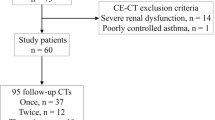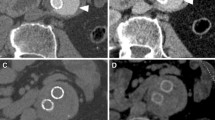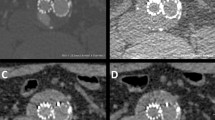Abstract
Purpose
To evaluate the value of metal artifact reduction (MAR) post-processing and iodine MD images in fast kV-switching dual-energy computed tomography (DECT) in patients after endovascular aortic repair (EVAR).
Materials and methods
Twenty-four consecutive EVAR patients (age 76 ± 9 years, 7/24 (29%) with coils, 9/24 (37.5%) with 10 endoleaks) who underwent DECT angiography were included in this HIPAA-compliant, IRB-approved retrospective study. Monochromatic reconstructions included 55, 60, 65, 70, and 75 keV with and without MAR and iodine MD images. Near field, far field, and vessel artifacts were assessed subjectively (1 = none; 5 = severe) and objectively by measuring noise and contrast-to-noise ratio. Visibility of endoleak was evaluated (1 = optimal; 5 = not visible).
Results
MAR objectively decreased artifacts from EVAR stents in the near field (60.7 ± 25.4 HU vs. 70.1 ± 34.2; p = .002) and subjectively increased near field (3.2 ± 0.9 vs. 2.8 ± 0.6; p < .001), far field (2.2 ± 0.6 vs. 1.6 ± 0.6; p < .001), and vessel (3.1 ± 1.1 vs. 2.5 ± 0.9; p < .001) artifacts. Near-field artifacts from coils were reduced by the MAR objectively (72.4 ± 24.8 vs. 182.7 ± 57.3 HU; p < .001) and subjectively (4.5 ± 0.5 vs. 4.9 ± 0.4; p = .02). CNR of standard reconstructions was optimal at 60 keV (38.3 ± 16.8). Reconstructions without MAR and iodine MD images provided improved endoleak visualization in 6/10 (60%) of cases (median 1 for both) compared to MAR (median 3) (p < 0.001). However, MAR improved visualization in 1/10 (10%) cases due to endoleak location adjacent to a coil.
Conclusion
DECT with MAR reduced artifacts from coils and improved endoleak visualization in 1/10 (10%) cases due to location adjacent to a coil. However, MAR impaired endoleak visualization in 6/10 (60%) cases and should be reviewed combined with 60 keV standard reconstructions and iodine MD images.




Similar content being viewed by others
References
Stavropoulos SW, Marin H, Fairman RM, et al. (2005) Recurrent endoleak detection and measurement of aneurysm size with CTA after coil embolization of endoleaks. J Vasc Interv Radiol JVIR 16:1313–1317
Dong Y, Shi AJ, Wu JL, et al. (2015) Metal artifact reduction using virtual monochromatic images for patients with pedicle screws implants on CT. Eur Spine J 25:1754–1763
Jia Y, Zhang J, Fan J, et al. (2015) Gemstone spectral imaging reduced artefacts from metal coils or clips after treatment of cerebral aneurysms: a retrospective study of 35 patients. Br J Radiol 88:20150222
Stefaniak K, Stanisic M, Gabriel M, Oszkinis G (2016) Diagnostic imaging methods applied in long-term surveillance after EVAR. Will computed tomography angiography be replaced by other methods? Postępy Kardiol Interwencyjnej 12:6–12
Brook OR, Gourtsoyianni S, Brook A, et al. (2012) Spectral CT with metal artifacts reduction software for improvement of tumor visibility in the vicinity of gold fiducial markers. Radiology 263:696–705
Laks S, Macari M, Chandarana H (2010) Dual-energy computed tomography imaging of the aorta after endovascular repair of abdominal aortic aneurysm. Semin Ultrasound CT MR 31:292–300
Boos J, Sawicki LM, Lanzman RS, et al. (2016) Metal artifact reduction (MAR) based on two-compartment physical modeling: evaluation in patients with hip implants. Acta Radiol. doi:10.1177/0284185116633911
Sonoda A, Nitta N, Ushio N, et al. (2015) Evaluation of the quality of CT images acquired with the single energy metal artifact reduction (SEMAR) algorithm in patients with hip and dental prostheses and aneurysm embolization coils. Jpn J Radiol 33:710–716
Wuest W, May MS, Brand M, et al. (2015) Improved image quality in head and neck CT using a 3D iterative approach to reduce metal artifact. AJNR Am J Neuroradiol 36:1988–1993
Andersson KM, Nowik P, Persliden J, Thunberg P, Norrman E (2015) Metal artefact reduction in CT imaging of hip prostheses—an evaluation of commercial techniques provided by four vendors. Br J Radiol 88:20140473
Lee YH, Park KK, Song H-T, Kim S, Suh J-S (2012) Metal artefact reduction in gemstone spectral imaging dual-energy CT with and without metal artefact reduction software. Eur Radiol 22:1331–1340
Kuchenbecker S, Faby S, Sawall S, Lell M, Kachelrieß M (2015) Dual energy CT: how well can pseudo-monochromatic imaging reduce metal artifacts? Med Phys 42:1023–1036
Pessis E, Campagna R, Sverzut J-M, et al. (2013) Virtual monochromatic spectral imaging with fast kilovoltage switching: reduction of metal artifacts at CT. Radiographics 33:573–583
Pessis E, Sverzut J-M, Campagna R, et al. (2015) Reduction of metal artifact with dual-energy CT: virtual monospectral imaging with fast kilovoltage switching and metal artifact reduction software. Semin Musculoskelet Radiol 19:446–455
Shinohara Y, Sakamoto M, Iwata N, et al. (1987) Usefulness of monochromatic imaging with metal artifact reduction software for computed tomography angiography after intracranial aneurysm coil embolization. Acta Radiol Stockh Swed 2014(55):1015–1023
Ascenti G, Mazziotti S, Lamberto S, et al. (2011) Dual-energy CT for detection of endoleaks after endovascular abdominal aneurysm repair: usefulness of colored iodine overlay. AJR Am J Roentgenol 196:1408–1414
Buffa V, Solazzo A, D’Auria V, et al. (2014) Dual-source dual-energy CT: dose reduction after endovascular abdominal aortic aneurysm repair. Radiol Med (Torino) 119:934–941
Maturen KE, Kaza RK, Liu PS, et al. (2012) “Sweet spot” for endoleak detection: optimizing contrast to noise using low keV reconstructions from fast-switch kVp dual-energy CT. J Comput Assist Tomogr 36:83–87
Maturen KE, Kleaveland PA, Kaza RK, et al. (2011) Aortic endograft surveillance: use of fast-switch kVp dual-energy computed tomography with virtual noncontrast imaging. J Comput Assist Tomogr 35:742–746
Landis JR, Koch GG (1977) The measurement of observer agreement for categorical data. Biometrics 33:159–174
Huang JY, Kerns JR, Nute JL, et al. (2015) An evaluation of three commercially available metal artifact reduction methods for CT imaging. Phys Med Biol 60:1047–1067
Han SC, Chung YE, Lee YH, et al. (2014) Metal artifact reduction software used with abdominopelvic dual-energy CT of patients with metal hip prostheses: assessment of image quality and clinical feasibility. AJR Am J Roentgenol 203:788–795
Ellmann S, Kammerer F, Brand M, et al. (2016) A novel pairwise comparison-based method to determine radiation dose reduction potentials of iterative reconstruction algorithms, exemplified through circle of willis computed tomography angiography. Invest Radiol 51:331–339
Goetti R, Winklehner A, Gordic S, et al. (2012) Automated attenuation-based kilovoltage selection: preliminary observations in patients after endovascular aneurysm repair of the abdominal aorta. AJR Am J Roentgenol 199:W380–385
Sudarski S, Apfaltrer P, Nance JW, et al. (2013) Optimization of keV-settings in abdominal and lower extremity dual-source dual-energy CT angiography determined with virtual monoenergetic imaging. Eur J Radiol 82:e574–581
Author information
Authors and Affiliations
Corresponding author
Ethics declarations
Funding
No funding was received for this study.
Conflict of interest
The authors declare that they have no conflict of interest.
Ethical approval
All procedures performed in studies involving human participants were in accordance with the ethical standards of the institutional and/or national research committee and with the 1964 Helsinki declaration and its later amendments or comparable ethical standards. For this type of study formal consent is not required.
Informed consent
Written informed consent was waived by the IRB.
Rights and permissions
About this article
Cite this article
Boos, J., Fang, J., Heidinger, B.H. et al. Dual energy CT angiography: pros and cons of dual-energy metal artifact reduction algorithm in patients after endovascular aortic repair. Abdom Radiol 42, 749–758 (2017). https://doi.org/10.1007/s00261-016-0973-7
Published:
Issue Date:
DOI: https://doi.org/10.1007/s00261-016-0973-7




